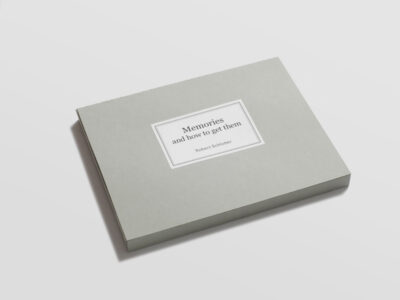In Memories and how to get them beschäftige ich mich mit der Folge von wahrnehmen, empfinden und reflektieren. Es gibt nicht ‚eine’ Wirklichkeit. Durch die subjektive Betrachtung der Umwelt eines jeden von uns ergibt sich immer auch ein subjektives Abbild dieser. Ich will da anschließen wo sich die Bilder die als Repräsentation des Erlebten im Erinnerungsbewusstsein vorhanden sind mit solchen überlagern, die als Zeichen für ein physisches Bild (durch Apparat erzeugt) Einzug in das Gedächtnis gefunden haben. Die Betrachtung der Erinnerung bzw. des autobiographischen Gedächtnisses, welches schließlich die eigene Wirklichkeit darstellt, als ein Konstrukt vager, latenter Bilder. Als Ausgangsmaterial für meine Arbeit verwende ich gefundene Super8-Amateurfilme. Ich reproduziere Filmbilder aus der laufenden Projektion. Je nach Intensität der Filmbewegung und entsprechender Belichtungszeit ergeben sich Überlagerungen und Bewegungsunschärfen die den endgültigen Bildern, ebenso wie den Bildern im Erinnerungsbewusstsein, einen vagen, latenten Charakter verleihen. Mit einer freien assoziativen Zusammenstellung der Bilder folge ich dem Prinzip der konstruktiven Funktionsweise des Gedächtnisses und dessen Drang der Erzeugung eines kohärenten Bildes des Ganzen welches uns umgibt.












Serie von insgesamt 22 Bildern.
Auflage von 5 Motiven,
Handabzug, Silbergelatineabzug auf Barytpapier,
110 x 133 cm, kaschiert auf Alu-Dibond, Auflage von 1 + 1 AP, signiert und nummeriert, 2009
Auflage von 22 Motiven,
Archiv-Pigmentprints auf Hahnemühle Photo Rag Baryta,
75 x 100 cm, Auflage von 5 + 2 ap, signiert und nummeriert, 2010
Es ist auch eine etwas taschenfreundlichere Ausgabe von Memories and how to get them im Format 125 x 160 mm erhältlich.
-

Memories and how to get them
220,00 €
Enthält 7% red. MwSt.zzgl. VersandAdditional costs (e.g. for customs or taxes) may occur when shipping to non-EU countries.In den Warenkorb
From «I was here» by Michèle Walerich
„Memories and how to get them wirft die Frage nach der latenten, fragmentarischen Natur der Fotografie auf. Einerseits führt ihr Wechsel zwischen Realität und Fiktion und umgekehrt zu einer quasi-unendlichen partizipativen Erzählung. Andererseits betont das Bewusstsein für die Vielfalt möglicher Darstellungsmöglichkeiten die Unmöglichkeit eines absoluten, wörtlichen Bildes und schärft unsere kritische Rezeption und die Art und Weise, wie wir mit Bildern umgehen. Dieses Thema ist noch relevanter, wenn die Fotografie als Mittel zur Reflexion über die Vergangenheit und zur kollektiven Erinnerung verwendet wird. Entgegen der landläufigen Meinung ist das Gedächtnis kein stabiles Reservoir, sondern wird durch den Akt der Erinnerung selbst geformt. Jede Veränderung der Weltanschauung bringt neue Mittel zu ihrer Konstruktion mit sich.“ – aus dem englischen mit Google Translate
erschienen in: Tourists & Nomads, Marburg 2012, ISBN 978-3-89445-464-7
Auszug aus dem Essay «Beyond Irony» von Daniel Neugebauer
„[…] Schlotter verspürt definitiv den Drang, einer süßlichen und oberflächlichen Melancholie der allgegenwärtigen Instagram-Bilder oder der Lana del Rey-Musikvideos mit ihrem vorgetäuschten Historizismus zu entgehen. Er schafft Hyperbilder als Gegenentwurf zur hyperrealistischen Ästhetik. Sie sind erfolgreich, weil sie Verantwortung für das Dargestellte übernehmen. Sie feiern nicht die Auflösung der Unterscheidung zwischen dem, was wahr ist und dem, was nicht wahr ist. Stattdessen zeigen sie den Mechanismus unseres Gedächtnisses als Quelle der Bildproduktion. […]“ – aus dem englischen mit Google Translate
erschienen in: The Space Beyond, Bielefeld 2014, ISBN 978-3-9812239-4-1
Auszug aus dem Essay «The Space Beyond» von Katharina Bosse
„[…] Die Ankündigung von etwas, das bald zu Ende geht, ist es, was meinen Blick in Robert Schlotters Bildern fesselt. Die Langzeitbelichtungen altmodischer Amateurfilme fragmentieren die Zeit auf andere Weise als Cartier-Bressons Reflex-Action-Aufnahmen. Schlotters Fotografien erscheinen wie passive Aufbewahrungsorte, in denen das bewegte Bild gefangen ist. Filme gerinnen zu Fotografien und verlieren ihre zeitliche Dimension; was auf der Oberfläche zurückbleibt, ist das Licht der Projektionslampe, eingefasst von einem dunklen Rahmen. Die Bilder in Memories and How to Get Them, mit ihrer unheimlichen Qualität eines geisterhaften Roadtrips, lassen mich an das Vergehen der Zeit denken, an den Tod von Roland Barthes. […]“ – aus dem englischen mit Google Translate
erschienen in: The Space Beyond, Bielefeld 2014, ISBN 978-3-9812239-4-1
